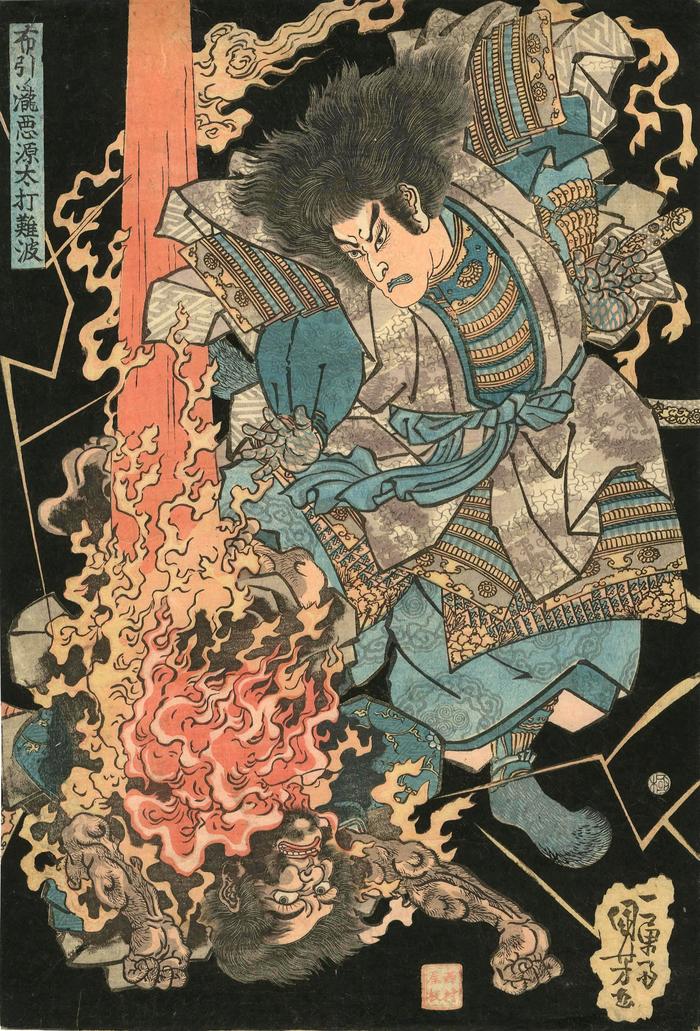Utagawa Kuniyoshi (歌川国芳) (artist 11/15/1797 – 03/05/1861)
Akugenda Slaying Namba Jirō at Nunobiki Falls - Nunobiki no taki Akugenda Nanba o utsu (布引ノ滝悪源太討難波)
ca 1834
10.25 in x 15.5 in (Overall dimensions) Japanese woodblock prints
Signed: Ichiyūsai Kuniyoshi ga
一勇斎国芳画
Publisher: Nishimuraya Yohachi
(Marks 391 - seal 16-083)
Censor's seal: kiwame
British Museum
Museum of Fine Arts, Boston
Museum of Fine Arts - ca. 1825 Kuniyoshi triptych of this scene
Google maps - Nunobiki Falls
Lyon Collection - Hokuba print related to this theme
National Museum of Asian Art Kuniyoshi and several of his pupils created images of the ghost of Akugenda Yoshihira slaying his slayer, Namba Jirō. In fact, Kuniyoshi illustrated this episode more than once.
Kuniyoshi's most successful follower, Yoshitoshi produced his own version as one of his 'Thirty-six Ghosts' series. John Stevenson wrote about this event.
"Minamoto no Yoshihira (1140-60) was only fifteen when he earned the nickname Kamakura Agenta, Wicked Genta of Kamakura, by murdering his uncle Yoshikata and other relatives.
In 1159, at the age of nineteen, Yoshira left Kamakura to join his father in Kyoto, where they fought together against Taira no Shigemori. They were defeated and fled; his father was assassinated by a Taira agent soon after. Yoshihira went back to Kyoto to seek revenge, disguised as a peasant. He was recognized, captured, and taken before Shigemori's father, Taira no Kiyomori, for judgment. Kiyomori... was delighted at his good fortune and ordered Yoshihira's immediate execution at the hands of Namba no Jiro. Yoshihira was led away to Nunobiki Waterfall where Namba cut him down with a sword. Yoshiria's body sprang into the air, taking the form of the Thunder God beating his drums. A violent thunderstorm rocked the sky, and Namba was killed in an explosive flash of lightning."
Quoted from: Yoshitoshi's Thirty-Six Ghosts by John Stevenson, p. 56. [You may have noticed that some sources spell the name 'Akugenta' occasionally as 'Akugenda'. There does not seem to be any consistency in which spelling is chosen. That is probably because 't' and 'd' are phonetically close, so close, in fact, that they are often interchangeable. John Stevenson chose to spell it with a 't' while the curators at the British Museum and the Museum of Fine Arts in Boston use the 'd' spelling. Either is acceptable. However, there is one major drawback: when doing research on this character the student or scholar should search under both versions to make sure they don't miss extra information that might be ought there on the internet.]
****
Here is another retelling of this event, but with a slightly different variation on the names, but the same protagonists.
“According to the Heiji monogatari, which records the Heike’s defeat of Minamoto no Yoshitomo during the Heiji Rebellion, the Minamoto warrior Akugenda Yoshihira, who was beheaded by the Taira retainer Nanba no Saburō Tsunefusa, later returned in the form of a lightning bolt and struck Tsunefusa dead in an act revenge.”
****
Nunobiki-no-taki 布引の滝
"In the bustle of this modern city, you wouldn't think that one of Japan's most impressive waterfalls is just behind the train station. Nunobiki Falls has four gushing cascades in the forests of Mt. Rokko. References to their beauty have appeared in Japanese literature since the 10th century. They are a 20-minute walk from Shin-Kobe Station. After the falls you can pick up the Shin-Kobe Ropeway, which stops just above the falls before continuing on to the Nunobiki Herb Park. The stopping point provides a beautiful view of the city, especially at night."
Quoted from: Fodor's Japan, p. 552.
****
Illustrated:
1) in black and white in Chimi moryō no sekai : Ukiyoe : Edo no gekiga--reikai, makai no shujinkō-tachi (浮世絵魑魅魍魎の世界: 江戶の劇画 : 霊界魔界の主人公たち) by 中右瑛 (Nakau Ei), Ribun Shuppan, Tokyo, 1987, p. 89. [The text is entirely in Japanese.]
2) in a small black and white reproduction in Kuniyoshi: The Warrior Prints by B. W. Robinson, Cornell University Press, Ithaca, 1982, p. 100. S1c.4. Robinson described this print: "The (rather unghostly) ghost of Akugenda Yoshihira executes vengeance with a thunderbolt on his slayer, Namba Jirō."
3) in color in Utagawa Kuniyoshi: 342 Color Paintings [sic] of Utagawa Kuniyoshi by Jacek Michalak, Kindle Edition, 2022, unpaginated.
warrior prints (musha-e - 武者絵) (genre)
Yūrei-zu (幽霊図 - ghosts demons monsters and spirits) (genre)
Nishimuraya Yohachi (西村屋与八) (publisher)
